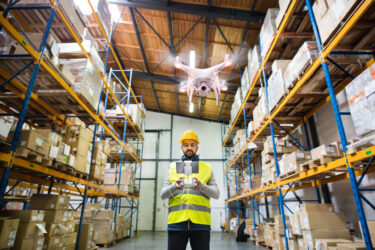

Various research and surveys show that companies lose 15-20% of Returnable Transport Items annually. In total, plastic pallet and container loss within the U.S. only is estimated to be between $800M and $1.5B annually. Our team took a challenge to fix this problem and created RTIs balancing solution.
Odyssey Momentum hackathon
Last weekend we participated in the Odyssey Momentum hackathon, an online event of 49 hours where complex 21st-century challenges were being solved. An immersive experience was combined with a game and meeting design that is entirely focused on collaboration. Odyssey Momentum was the premiere of the online mass collaboration arena. It was a completely new virtual world where connections, partnerships, and valuable solutions arbuilt.
During Odyssey Momentum, we were among 105 teams working on 21 challenges. Each team’s goal was to deliver a solution with the potential of becoming a part of multi-stakeholder ecosystems. Our team applied to tackle the Internet of Logistics challenge. Our track was focusing on circular economy for freight packaging and was hosted by TVM is a Dutch mutual insurance company specializing in providing insurance to transportation companies.
The goal of our project was to provide an automated balancing and tracking of Returnable Transport Items in broad and complex logistics ecosystems.
What are Returnable Transport Items?
Returnable transport items (RTI) are containers used multiple times by manufacturers to avoid the cost of purchasing new shipping material each time their product is distributed to a customer location. Plainly speaking, RTIs, is an umbrella term for various types of reusable packaging used in freight transportation, including pallets, crates, beer kegs, roll cages, totes, or racks, as well as shipping containers.
Freight packaging is often lost, stolen, or simply not reused. According to TVM, this may cost a single transporter €150,000 to €3,000,000 a year, in addition to the environmental impact of replacing trolleys, pallets, and crates.
What is the solution?
Our team proposed a simple and cost-effective solution that could be implemented easily in any existing logistics IT infrastructure. Based on previous interviews, including our business partner and logistics operator Rohlig-Suus, we concluded that besides tracking RTIs, we could provide an efficient way of balancing and exchanging them between participants of the entire logistics ecosystem. Replacing paper documents with digital and automated registry lowers the cost of operations around moving empty pallets from one site to another.
The aim was to design and build a working prototype of a simple (and cheap) IoT network employed for RTIs tracking and create an automated balancing system based on a zero-sum game. No one in the ecosystem can access business-related fragile information.
Potential users of the system gain the following value:
- Ownership tracking independent from any logistics system,
- Fine-grained Returnable Transport Items visibility,
- Real-time access to confirmed information about RTI balance,
- Improvement of freight monitoring not covered by other systems.
How did we do it?
The Odyssey Momentum hackathon seemed to be a perfect opportunity to get our team motivated and excited with a new project challenge. We have sent them to a cozy apartment in the middle of Gdansk Old Town, where they got provided with food, drinks, and fast internet access. As the event was planned to be an offline event when we applied, which changed later due to the covid-19 pandemic, we wanted to provide the team with at least a bit of the hackathon vibes, where they can code all day and all night while sipping beer and eating pizza.
The event started on Friday at 2 pm. DAC.digital developers met in their temporary hackers’ place and started with a traditional stan-up while agreeing on the workflow and distributing tasks between each other.
The designed solution could be depicted more or less in the following way:

Technical details
The time pressure was enormous since the team had only 49h in total (including nighttime) to bring the working prototype to life. They decided to employ Bluetooth Low Energy, battery-powered beacons as tracking devices attached to pallets, Raspberry Pi 4 as beacons scanners and GPS position tracker, and blockchain-based smart contracts for storing ecosystem balances of RTIs.
The freight location was to be displayed on a map (OpenStreetMap), allowing ecosystem participants to track their items. To enhance the efficiency of RTIs balancing, we allowed parties in need of empty pallets to check on the map where the closest partner with free RTIs to exchange is.
On the last day of the hackathon, we had a fully working prototype demonstrated to the jury live. We’ve mocked the freight transportation process from loading in the sender’s warehouse to unloading the truck at the site of delivery. The demonstration included a live alert of a lost item.
The team has spent together the whole weekend, leaving the apartment only for a short walk around the Old Town.

Results
Unlike the last year in Berlin, this time we did not make it to win within our track. However, the presented prototype has impressed the Jury and other participants of the hackathon. Integrating hardware and software components and implementation of blockchain within less than 49h seemed to be impossible. But there is nothing impossible for the DAC team!
Now we are looking forward to pilot implementations and testing of our solution in a real-life environment. Soon our dev team will release technical details of the prototype on our Medium Technology Blog. Stay tuned!




